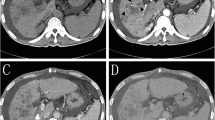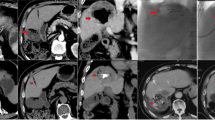Abstract
Purpose
The purpose of this study was to report on the 5-year survival of hepatocellular carcinoma (HCC) patients treated with DC Bead loaded with doxorubicin (DEB-DOX) in a scheduled scheme in up to three treatments and thereafter on demand.
Materials and Methods
173 HCC patients not suitable for curable treatments were prospectively enrolled (mean age 70.4 ± 7.4 years). Child-Pugh (Child) class was A/B (102/71 [59/41 %]), Okuda stage was 0/1/2 (91/61/19 [53.2/35.7/11.1 %]), and mean lesion diameter was 7.6 ± 2.1 cm. Lesion morphology was one dominant ≤5 cm (22 %), one dominant >5 cm (41.6 %), multifocal ≤5 (26 %), and multifocal >5 (10.4 %).
Results
Overall survival at 1, 2, 3, 4, and 5 years was 93.6, 83.8, 62, 41.04, and 22.5 %, with higher rates achieved in Child class A compared with Child class B patients (95, 88.2, 61.7, 45, and 29.4 % vs. 91.5, 75, 50.7, 35.2, and 12.8 %). Mean overall survival was 43.8 months (range 1.2–64.8). Cumulative survival was better for Child class A compared with Child class B patients (p = 0.029). For patients with dominant lesions ≤5 cm 1-, 2-, 3-, 4-, and 5-year survival rates were 100, 95.2, 71.4, 66.6, and 47.6 % for Child class A and 94.1, 88.2, 58.8, 41.2, 29.4, and 23.5 % for Child class B patients. Regarding DEB-DOX treatment, multivariate analysis identified number of lesions (p = 0.033), lesion vascularity (p < 0.0001), initially achieved complete response (p < 0.0001), and objective response (p = 0.046) as significant and independent determinants of 5-year survival.
Conclusion
DEB-DOX results, with high rates of 5-year survival for patients, not amenable to curative treatments. Number of lesions, lesion vascularity, and local response were significant independent determinants of 5-year survival.



Similar content being viewed by others
References
Lo CM, Ngan H, Tso WK et al (2002) Randomized controlled trial of transarterial lipiodol chemoembolization for unresectable hepatocellular carcinoma. Hepatology 35(5):1164–1171
Llovet JM, Real MI, Montana X et al (2002) Barcelona Liver Cancer Group. Arterial embolisation or chemoembolisation versus symptomatic treatment in patients with unresectable hepatocellular carcinoma: a randomized controlled trial. Lancet 359(9319):1734–1739
Lammer J, Malagari K, Vogl T et al (2010) PRECISION V Investigators. Prospective randomized study of doxorubicin-eluting-bead embolization in the treatment of hepatocellular carcinoma: results of the PRECISION V study. Cardiovasc Intervent Radiol 33(1):41–52
Varela M, Real MI, Burrel M et al (2007) Chemoembolization of hepatocellular carcinoma with drug eluting beads: efficacy and doxorubicin pharmacokinetics. J Hepatol 46(3):474–481
Poon RN, Tso WK, Pang RWC et al (2007) A phase I/II trial of chemoembolization for hepatocellular carcinoma using a novel intra-arterial drug-eluting bead. Clin Gastroenterol Hepatol 5(9):1100–1108
Kettenbach J, Stadler A, Katzler I et al (2008) Drug-loaded microspheres for the treatment of liver cancer: review of current results. Cardiovasc Intervent Radiol 31(3):468–476
Malagari K, Chatzimichael K, Alexopoulou E et al (2008) Transarterial chemoembolisation of unresectable hepatocellular carcinoma (HCC) with drug eluting beads (DEB)” Results of an open label study of 62 patients. Cardiovasc Intervent Radiol 31(2):269–280
Malagari K, Alexopoulou E, Chatzimichail K et al (2008) Transcatheter chemoembolization in the treatment of HCC in patients not eligible for curative treatments: midterm results of doxorubicin-loaded DC BeadTM. Abdom Imaging 33(5):512–519
Reyes DK, Vossen JA, Kamel IR et al (2009) Single-center phase II trial of transarterial chemoembolization with drug-eluting beads for patients with unresectable hepatocellular carcinoma: initial experience in the United States. Cancer J 15(6):526–532
Poggi G, Quaretti P, Minoia C et al (2008) Transhepatic arterial chemoembolization with oxaliplatin-eluting microspheres (OEM-TACE) for unresectable hepatic tumors. Anticancer Res 28(6B):3835–3842
Biondi M, Fusco S, Lewis AL et al (2012) New insights into the mechanisms of the interactions between doxorubicin and the ion-exchange hydrogel DC Bead™ for use in transarterial chemoembolization (TACE). J Biomater Sci Polym Ed 23(1–4):333–354
Malagari K, Pomoni M, Spyridopoulos TN et al (2011) Safety profile of sequential transcatheter chemoembolization with DC Bead(™): results of 237 hepatocellular carcinoma (HCC) patients. Cardiovasc Intervent Radiol 34(4):774–785
National Cancer Institute (2003) Common Terminology Criteria for Adverse Events, version 3.0. National Cancer Institute, Bethesda, Maryland
Common Terminology Criteria for Adverse Events (CTCAE) v3.0 (2003) Notice of Modifications March 31, 2003–June 10, 2003
Bruix J, Sherman M, Llovet JM et al (2001) EASL panel of experts on HCC. Clinical management of hepatocellular carcinoma. Conclusions of the Barcelona-2000 EASL conference. European Association for the Study of the Liver. J Hepatol 35(3):421–430
Marelli L, Stigliano R, Triantos C et al (2007) Transarterial therapy for hepatocellular carcinoma: which technique is more effective? A systematic review of cohort and randomized studies. Cardiovasc Intervent Radiol 30(1):6–25
Vogl TJ, Naguib NN, Nour-Eldin NE et al (2009) Review on transarterial chemoembolization in hepatocellular carcinoma: palliative, combined, neoadjuvant, bridging, and symptomatic indications. Eur J Radiol 72(3):116–505
Bruix J, Llovet JM (2009) Major achievements in hepatocellular carcinoma. Lancet 373(9664):614–616
Raoul JL, Sangro B, Forner A et al (2011) Evolving strategies for the management of intermediate-stage hepatocellular carcinoma: available evidence and expert opinion on the use of transarterial chemoembolization. Cancer Treat Rev 37(3):212–220
O’Suilleabhain CB, Poon RTP, Yong JL et al (2003) Factors predictive of 5-year survival after transarterial chemoembolization for inoperable hepatocellular carcinoma. Br J Surg 90(3):325–331
Takayasu K, Arii S, Ikai I et al (2006) Liver Cancer Study Group of Japan. Prospective cohort study of transarterial chemoembolization for unresectable hepatocellular carcinoma in 8,510 patients. Gastroenterology 131(2):461–469
Maeda S, Fujiyama S, Tanaka M et al (2002) Survival and local recurrence rates of hepatocellular carcinoma patients treated by transarterial chemolipiodolization with and without embolization. Hepatol Res 23(3):202–210
Hayashi K, Ina H, Tezuka M et al (2007) Local therapeutic results of computed tomography-guided transcatheter arterial chemoembolization for hepatocellular carcinoma: results of 265 tumors in 79 patients. Cardiovasc Intervent Radiol 30(6):1144–1155
Lencioni R, Cioni D, Crocetti L et al (2005) Early-stage hepatocellular carcinoma in patients with cirrhosis: long-term results of percutaneous image-guided radiofrequency ablation. Radiology 234(3):961–967
Montorsi M, Santambrogio R, Bianchi P et al (2005) Survival and recurrences after hepatic resection or radiofrequency for hepatocellular carcinoma in cirrhotic patients: a multivariate analysis. J Gastrointest Surg 9(1):62–68
Omata M, Tateishi R, Yoshida H et al (2004) Treatment of hepatocellular carcinoma by percutaneous tumor ablation methods: ethanol injection therapy and radiofrequency ablation. Gastroenterology 127(5 Suppl 1):159–166
Lam VW, Ng KK, Chok KS et al (2008) Risk factors and prognostic factors of local recurrence after radiofrequency ablation of hepatocellular carcinoma. J Am Coll Surg 207(1):20–29
Lee KH, Liapi E, Vossen JA et al (2008) Distribution of iron oxide-containing embosphere particles after transcatheter arterial embolization in an animal model of liver cancer: evaluation with MR imaging and implication for therapy. J Vasc Interv Radiol 19(10):1490–1496
Burrel M, Reig M, Forner A, et al. (2012) Survival of patients with hepatocellular carcinoma treated by transarterial chemoembolization (TACE) using DC Beads. Implications for clinical practice and trial design. J Hepatol. doi:10.1016/j.jhep.2012.01.008
Lee JK, Chung YH, Song BC et al (2002) Recurrences of hepatocellular carcinoma following initial remission by transcatheter arterial chemoembolization. J Gastroenterol Hepatol 17(1):52–58
Grieco A, Marcoccia S, Miele L et al (2003) Transarterial hemoembolisation (TACE) for unresectable hepatocellular carcinoma in cirrhotics: functional hepatic reserve and survival. Hepatogastroenterology 50(49):207–212
Memon K, Kulik L, Lewandowski RJ et al (2011) Radiographic response to locoregional therapy in hepatocellular carcinoma predicts patient survival times. Gastroenterology 141(2):526–535
Kwok PC, Lam TW, Chan SC et al (2000) A randomized clinical trial comparing autologous blood clot and gelfoam in transarterial chemoembolization for inoperable hepatocellular carcinoma. J Hepatol 32(6):955–964
Ernst O, Sergent G, Mizrahi D et al (1999) Treatment of hepatocellular carcinoma by transcatheter arterial chemoembolization: comparison of planned periodic chemoembolization and chemoembolization based on tumor response. AJR Am J Roentgenol 172(1):59–64
Herber SC, Otto G, Schneider J et al (2008) Transarterial chemoembolization in patients not eligible for liver transplantation: single-center results. AJR Am J Roentgenol 190(4):1035–1042
Venook AP, Stagg RJ, Lewis BJ et al (1990) Chemoembolization for hepatocellular carcinoma. J Clin Oncol 8(6):1108–1114
Lencioni R, De Baere Th, Burrel M, et al. (2011) Transcatheter treatment of hepatocellular carcinoma with doxorubicin loaded DC Bead (DEBDOX): technical recommendations. Cardiovasc Intervent Radiol. doi:10.1007/s00270-011-0287-7
Brown DB, Nikolic B, Covey AM et al (2012) Quality improvement guidelines for transhepatic arterial chemoembolization, embolization, and chemotherapeutic infusion for hepatic malignancy. J Vasc Interv Radiol 23:287–294
Conflict of interest
None
Author information
Authors and Affiliations
Corresponding author
Rights and permissions
About this article
Cite this article
Malagari, K., Pomoni, M., Moschouris, H. et al. Chemoembolization With Doxorubicin-Eluting Beads for Unresectable Hepatocellular Carcinoma: Five-Year Survival Analysis. Cardiovasc Intervent Radiol 35, 1119–1128 (2012). https://doi.org/10.1007/s00270-012-0394-0
Received:
Accepted:
Published:
Issue Date:
DOI: https://doi.org/10.1007/s00270-012-0394-0




